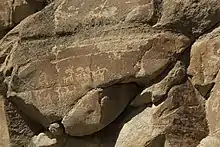Sacred Rock of Hunza
The Sacred Rock of Hunza is carved rock as well as a cultural heritage site in Gilgit-Baltistan, Pakistan. The carvings on the rock dates back to the 1st Millennium AD. The rock is on a top of a hill which lies in east to the Hunza River. The site is on the main Karakoram Highway (KKH) in between Ganish village and Attabad Lake. The rock is divided into two parts, once there used to be some Buddhist shelter caves which fell over time. The rock is one of the major tourist attractions in Gilgit-Baltistan.[1]
| Sacred Rock of Hunza | |
|---|---|
 | |
| Location | Hunza, Gilgit-Baltistan, Pakistan |
| Coordinates | 36.3131816°N 74.6860350°E |
| Area | Gilgit-Baltistan |
| Formed | 1st Millennium AD |
| Restored by | Government of Pakistan |
| Owner | Commissioner of Northern Areas, Director of Archaeology, Government of Pakistan |
Location
The sacred rock is located in place called Haldeikish near to the small town of Karimabad in Hunza Valley. The site is on top of a Hill which is at the left bank of the river Hunza.[1] The rock is 30 feet high and 200 yards long. It is easily accessible from the Karakoram Highway which connects Pakistan with China. It is an isolated rock which is further divided into two portions.
Specifications
The Sacred Rock is divided into two portions, an upper portion and a lower one. Both the portions carry carvings on them which are basically inscriptions and images from Pre-Historic era. There used to be many Buddhist shelter caves in ancient times which later collapsed or fell over the time.[2]
Upper Portion
The upper portion of the rock consist of inscriptions which are carved in Sogdian, Kharosthi, Brahmi, Sarada and Proto Sarada languages. The names of the Emperors of the Kushana Empire appear in these inscriptions as well as the names of other Emperors from the Empires of Kanishka and Huvishka. The name of the Trukha King Ramadusa is also mentioned in inscriptions which are carved in Brahmi language.[1]
Lower Portion
The lower portion is engraved by the images of Ibexes. These ibexes are shown in different situations, including being hunted. The carvings also contain Horned-Human deities playing with the ibexes. The carvings of the Ibexes are a proof of the ibex being an animal which holds cultural importance to Buddhists as well as to the region in ancient times. One of the carvings also shows the image of an ancient Chinese King. Some carvings show a Tibetan styled Stupa.[1]
Inscription mentioning Chandragupta II
The inscription mentioning Chandragupta II of Gupta empire reads ''Chandra Sri Vikramaditya conquers’' with a date corresponding to 419 AD.[3]
Preservation
The Sacred Rock of Hunza is a Cultural Heritage Site of Pakistan and is currently well preserved but still some the carvings carrying inscriptions are effected due to aging. There were many Buddhist shelter caves which fell over time and no more exist. Commissioner of Northern Areas of Pakistan and Director of Archaeology are responsible for the preservation of the site, both acting under the Government of Pakistan. Due to recent flooding in Hunza River the site faces extreme danger in future.[1]
See also
| Wikimedia Commons has media related to Sacred Rock of Hunza. |
References
- "UNESDoc (UNESCO)" (PDF). Unesdoc.unesco.org. Retrieved 2014-07-05.
- "Sacred Rocks at Hunza - Ganish, Pakistan Ganish". Lonelyplanet.com. Retrieved 13 February 2019.
- "HALDEIKISH, Sacred Rocks of Hunza". Hunza Bytes. Retrieved 2020-10-20.